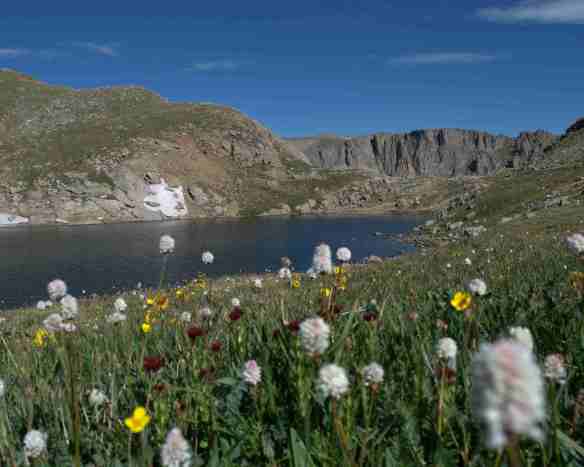I finally made it up to the tundra yesterday, not Trail Ridge Road this time, but Mt. Evans, outside of Denver.
Mt. Evans is nearly unique in the world in that it is a 14,130 foot mountain with a road essentially to the top (you have to park and walk the last thirty feet or so). It makes it an easy trip to get to my favorite biome — the alpine tundra.
I went up hoping, as always to see wildlife. But what I got an eyefull of was flowering plants.

Summit Lake flowers — American bistort, alpine avens, and goldflower.
This view is of Summit Lake, actually a mile or so before the actual summit. Initially, I was going to just take a picture of the white American bistort in the foreground, but this was such a beautiful shot, I took it first.
Goldflower is in the sunflower family. It is one of the larger flowers in the tundra, standing several inches tall. About half of that is take up with the big flower disk.

Fly pollinating Alpine Avens
One of the things that surprised me was the number of flies on the flowers. But then I found out that bees don’t make it up this high, and so flies are the main pollinators.

Fly on American bistort flowers.
I don’t get repulsed by much, but it is hard for me to have kind thoughts about flies in general. But if they are pollinating flowers, I guess I need to try to think better of them.

American bistort at 12,000 feet.
Bistorts are in the buckwheat family. This species is relatively large at several inches.

Alpine bistort.
Most alpine flowers, though are tiny, like this alpine bistort, standing about an inch tall. To get this shot, I had to lie down on my stomach, with my camera on the ground.

Purple fringe usually grows at lower altitudes, where it can stand upright.
Even if the plant normally grows upright, the frequent winds forces them low to the ground.

Alpine Indian paintbrush? If so, it, too, normally grows upright.
I had a heck of a time figuring out some of these plants. I think this is alpine Indian paintbrush. If you know, let me know.

Mountain goat blowing her winter coat. Look at how thick it is!
At the very top of Mt. Evans, I finally found some mountain goats. Mountain goats are different from Rocky Mountain bighorn sheep. They are goats (duh!), with very sharp horns and a hump at their shoulder.

Bighorn rams in the Big Thompson Canyon battle it out.
Bighorn sheep, on the other hand, have thick horns that they use to batter each other with. They have no hump at their shoulders.

Those are some great photos! Thanks for taking me along on your adventure. And I will also try to rethink my opinion of flies!
You know, every time I think I know my way around WordPress, I get lost again. I just found the reply button.
I’m glad you liked the adventure. It is just so different up there that there is always something new and fascinating to photograph.
HA re getting lost on WordPress. They like to switch things up, that’s for sure.
Keep the photos coming!
Amy, your alpine photos are spectacular! Thanks for sharing the beauty of Colorado. Well done.
Thanks! They were a bunch of fun to shoot.
Pingback: Aspen on Mt. Evans | Colorado Geography In Depth and At Altitude
Pingback: Correction: Tachinid flies | Colorado In Depth and At Altitude